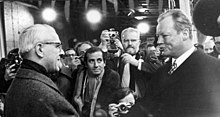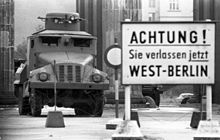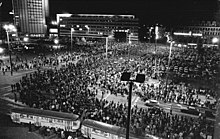Relations within Germany
With the intra-German relations or German-German relations , the political, economic, cultural and human contacts between the be the Federal Republic of Germany and the German Democratic Republic (GDR) at the time of German division called 1945-1990.
Periods of time

Process of the division of Germany in the shadow of international power relations
After the unconditional surrender of the Wehrmacht in May 1945, the anti-Hitler coalition between the USA and the Soviet Union broke up , and the idea of dividing the defeated country was from now on determined by the emerging East-West conflict ( Cold War ), the made the division within Germany an example of the “ Iron Curtain ” that was dividing the world .
Important milestones in the gradual demarcation were the US Marshall Plan in 1947 and the western currency reform and the Berlin blockade in 1948. The integration of the western zones of occupation into the community of western powers and that of the eastern part into the system of the Soviet Union finally accompanied the founding of the Federal Republic in 1949 and the GDR.
The Cold War came to a head
The outbreak of the Korean War in 1950 led to an intense debate in West Germany about German rearmament as a contribution to the defense of Western Europe within the framework of a European Defense Community (EDC). In 1955 the discussion culminated in joining the western military alliance of NATO and building a defense army , the Bundeswehr .
Economically, the young Federal Republic was tied to the Western powers on the basis of the Treaty of Rome of 1957, which led to membership in the European Economic Community (EEC) and the European Coal and Steel Community (ECSC), the precursors of today's European Union (EU ). In the meantime, the GDR was incorporated into the Eastern Bloc : the GDR joined the Council for Mutual Economic Aid (Comecon) and the Warsaw Pact with its newly founded National People's Army .
While Chancellor Konrad Adenauer succeeded in gradually bringing the Federal Republic of Germany closer to the West, reconciling the country with its European neighbors and finding a close partner in France , the German citizens benefited from the economic miracle , the upswing brought about by the market economy . The GDR government, on the other hand, relied on five-year plans and was only able to stabilize the economic situation slowly. Due to the lack of free elections , the SED also lacked legitimacy. a. led to the popular uprising on June 17, 1953 , which was ended with Soviet military help.
On 13 August 1961, the communist regime Berlin severed by the construction of the Berlin Wall de facto in East and West Berlin . The GDR thus put an end to the increasing emigration of the high-performing population and remaining hopes for an early reunification . The GDR was stabilized in this way. The people who remained in the GDR no longer had the opportunity to get to the West via West Berlin and had to come to terms with the regime.
Signs of relaxation
The Cuban Missile Crisis of 1962, when the world was on the verge of nuclear war , marked the turning point of the Cold War towards a policy of cooperation and détente , which, through a changed climate, also affected relations within Germany.

The new Ostpolitik of the social-liberal government under Federal Chancellor Willy Brandt played a decisive role in this. Even in the time before the grand coalition , which ended the Adenauer era in 1966, Brandt and his press spokesman Egon Bahr had prepared these guiding principles for foreign policy: the “politics of small steps”, “change through rapprochement” and “human relief”. Within just three years, following the symbolic start with the Erfurt summit in 1970, the Eastern Treaties with Moscow, Warsaw and Prague, the Four Power Agreement on Berlin , the declaration of non-violence against the Eastern European states and the basic treaty with the GDR came about. For the first time, the sovereignty of the other and the existing inner-German border were mutually recognized and the status of Berlin was secured. Strategies such as the Hallstein Doctrine , in which the Federal Republic of Germany formulated a claim to sole representation in the mid-1950s and rejected any diplomatic relations with countries that recognize the GDR, were now a thing of the past.
This policy of normalization also served reactively to defuse the international East-West conflict and set the prerequisites for the Conference on Security and Cooperation in Europe (CSCE) in 1975 and the talks on troop limits. However, the "regular coexistence" achieved cemented the status quo in such a way that after more than 20 years in both German states only a few believed that reunification was feasible.
In the GDR, people reacted to the new détente with new demarcation in order to find their own state identity. With its willingness to enter into dialogue, the state had achieved international recognition. In 1973 the Federal Republic and the GDR became members of the UN . Due to the increasing economic performance, the self-confidence of the nation also increased, which in 1974 led the Volkskammer to delete the terms German nation and reunification from the constitution of the German Democratic Republic . In 1971, Walter Ulbricht had already felt that too much independence could also lead to a conflict with the Soviet Union, who had been replaced by Erich Honecker in his function as the SED's first secretary because of his refusal to reform .
New challenges and opportunities

The two oil crises in the 1970s, however, had a devastating effect on the economic development of the GDR and led to dissatisfaction among the population, but not to structural reforms. Emerging opposition groups are fought by the close-knit network of state security spies in order to preserve political stability in the country.
Relations within Germany were disrupted by the Spiegel publication of the manifesto of the Federation of Democratic Communists in Germany in January 1978.
In the meantime, internal German relations are being strained by a new wave of international armament , which culminated in the NATO double decision and the Soviet occupation of Afghanistan in 1979. Domestically, the government under Chancellor Helmut Schmidt was no longer able to cope with these burdens and eventually paved the way for a black-yellow coalition under Chancellor Helmut Kohl . This tried not to lose contact with the neighboring German state, which had also been strengthened by Schmidt's visit to the GDR in 1981. It was also possible to save the GDR from financial ruin through billions in loans from West Germany alone. The refusal of the SED to transfer the reforms introduced by the Soviet head of state and party Mikhail Gorbachev to the GDR isolated the SED dictatorship to some extent within the communist camp.
1986 Eisenhüttenstadt and Saarlouis establish the first German-German city partnership .
In 1987, Honecker made the long-planned return visit to Schmidt's visit (see Erich Honecker 's visit to the Federal Republic of Germany 1987 ). The reception as a state guest with almost all military and other honors was viewed by the GDR leadership as the high point of ( de facto ) recognition.
On the way to unity
Gorbachev's reforms, however, had further consequences. In addition to the noticeable defuse of the international East-West conflict, especially the Cold War, through binding disarmament agreements between the USSR and the USA, the policy of the “ thaw ” also opened up new perspectives for the individual states of the Eastern Bloc.
After Moscow no longer stood in the way of gradual democratization , Hungary opened its border with Austria in August 1989 . With the onset of the mass exodus, the opposition movements within the GDR also experienced a new influx. Not only in Leipzig there were regular protest marches, the so-called Monday demonstrations . On the other hand, it was long too late to save the power of the SED: On the night of November 9-10, 1989, the GDR state apparatus surrendered to its own people. The opening of the Berlin Wall was a high point in the course of the peaceful revolution .
The "time window of history" now opened for reunification prompted everyone involved to act quickly: The SED offered the opposition round table talks , Helmut Kohl single-handedly presented his ten-point program for overcoming the division and the first legitimately elected The GDR government under Lothar de Maizière cleared the way for the takeover of the West German economic and social system and entry into the scope of the Basic Law for the Federal Republic of Germany .
However, since the victorious powers of the Second World War had to co-decide on the merger of the two German states, framework conditions were worked out jointly within the framework of the two-plus-four talks .
After 40 years of division, Germany was officially reunited with the hoisting of the German federal flag at midnight on the night of October 2 to 3, 1990 at the Reichstag building in Berlin. The question of intra-German relations is therefore to be regarded as irrelevant.
Treaties between the Federal Republic and the GDR
- Basic contract from 1972
- Status of the permanent representations
- Transit agreement
- Berlin Agreement
- GDR loan in the 1980s with the significant contribution of Franz Josef Strauss
- German-German cultural agreement of May 6, 1986
- Unification Treaty of 1990
See also
literature
- Andreas H. Apelt , Robert Grünbaum , Jens Schöne (Eds.): 2 x Germany. Relations within Germany 1972–1990 . Mitteldeutscher Verlag, Halle (Saale) 2013, ISBN 978-3-89812-961-9 .
- The history of the GDR . In: Information on Political Education No. 231 . Federal Agency for Civic Education, Bonn 1991.
- The division of Germany . In: Information on Political Education No. 232 . Federal Agency for Civic Education, Bonn 1991.
- International Relations I . In: Information on Political Education No. 245 . Federal Agency for Civic Education, Bonn 2000.
- The way to unity . In: Information on Political Education No. 250 . Federal Agency for Civic Education, Bonn 2005.
- German history. Volume 4: 1945-2000 . Weltbild, Augsburg 2001.
- History. Pocket Teacher . Cornelsen Verlag, Berlin 2000.
- Peter Krewer: Doing business with the class enemy. The GDR in internal German trade 1949–1989 , Kliomedia , Trier 2008, ISBN 978-3-89890-122-2 (dissertation University of Trier, 2007, 332 pages).
Web links
- Divided Germany at LeMO , Lebendiges Museum Online
- German-German history in picture and sound ( Memento from May 11, 2009 in the Internet Archive ) (tagesschau.de)


